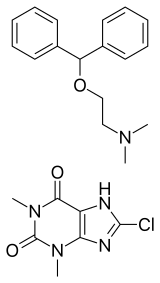Dimenhydrinate
 | |
| Combination of | |
|---|---|
| diphenhydramine | antiemetic |
| 8-chlorotheophylline | stimulant |
| Clinical data | |
| Trade names | Gravol, Dramamine |
| AHFS/Drugs.com | Monograph |
| MedlinePlus | a607046 |
| Pregnancy category | |
| Routes of administration | Oral, Rectal, I.V. |
| ATC code | |
| Legal status | |
| Legal status | |
| Identifiers | |
| CAS Number | |
| PubChem CID | |
| DrugBank | |
| ChemSpider | |
| UNII | |
| KEGG | |
| ChEMBL | |
| ECHA InfoCard | 100.007.593 |
| | |
Dimenhydrinate, marketed as Dramamine and Gravol among others, is an over-the-counter medication used to treat motion sickness and nausea. Dimenhydrinate is a combination of two drugs: diphenhydramine and 8-chlorotheophylline.
It is most commonly prepared as tablets, although it is also available in liquid form and in suppositories.
Medical uses
Dimenhydrinate is primarily used to treat nausea, vomiting, and dizziness caused by motion sickness.[1] Dimenhydrinate has also been found to aid in the treatment of ear congestion.
Diphenhydramine is the primary constituent of dimenhydrinate and dictates the primary effect. The main difference relative to pure diphenhydramine is a lower potency due to being combined with 8-chlorotheophylline. By weight, dimenhydrinate is between 53% to 55.5% diphenhydramine.[2]
8-Chlorotheophylline, a chlorinated derivative of theophylline, was added in order to counteract drowsiness. Theophylline is very closely related to caffeine and theobromine, mild central nervous system stimulants. It was thought by scientists that by combining the antiemetic effects of diphenhydramine with a stimulant, the extreme drowsiness induced by the former could be mitigated somewhat by the latter. The sedation caused by diphenhydramine, however, is substantially stronger than the stimulation caused by 8-chlorotheophylline, so the overall effect is still mostly sedating.
Recreational use
Dimenhydrinate is recreationally used as a deliriant.[3][4][5] Slang terms for Dramamine used this way include "drama", "dime", "dime tabs", "D-Q", "substance D", "d-house", and "drams".[6] Abusing Dramamine is sometimes referred to as Dramatizing or "going a dime a dozen", a reference to the amount of Dramamine tablets generally necessary for a trip.[7]
Many users report a side effect profile consistent with tropane alkaloid (e.g. atropine) poisoning as both show antagonism of muscarinic acetylcholine receptors in both the central and autonomic nervous system, which inhibits various signal transduction pathways.[4] In the CNS, diphenhydramine readily crosses the blood-brain barrier, exerting effects within the visual and auditory cortex.
Other CNS effects occur within the limbic system and hippocampus, causing confusion and temporary amnesia due to decreased acetylcholine signaling. Toxicology also manifests in the autonomic nervous system, primarily at the neuromuscular junction, resulting in ataxia and extrapyramidal side-effects and the feeling of heaviness in the legs, and at sympathetic post-ganglionic junctions, causing urinary retention, pupil dilation, tachycardia, irregular urination, and dry red skin caused by decreased exocrine gland secretions, and mucous membranes. Considerable overdosage can lead to myocardial infarction (heart attack), serious ventricular dysrhythmias, coma and death.[8] Such a side-effect profile is thought to give ethanolamine-class antihistamines a relatively low abuse liability. The specific antidote for dimenhydrinate poisoning is physostigmine, usually given by IV in a hospital.
Veterinary use
Dimenhydrinate has successfully been used as an antiemetic and sedative in housepets.[9] It is commonly used to reduce the effects of idiopathic vestibular syndrome.
Brand names
Dimenhydrinate is marketed under many brand names: in the USA, Mexico and Serbia as Dramamine, in Ukraine as Driminate, in India and Canada as Gravol, in Iceland as Gravamin, in Russia and Croatia as Dramina, in South Africa and Germany as Vomex, in Australia and Austria as Vertirosan, in Brazil as Dramin, in Ecuador as Anautin, in Hungary as Daedalon, in Sweden as Calma or Arlevert,[10] in Indonesia as Antimo, in Italy as Xamamina or Valontan, in Peru as Gravicoll, in Poland and Slovakia as Aviomarin,[11] in Portugal as Viabom, in Spain as Biodramina, in Thailand as ไดเมนนีน (Daimenin), and in Pakistan as Gravinate.[12]
References
- ↑ "Dimenhydrinate". MedlinePlus. National Institutes of Health. Retrieved 19 July 2014.
- ↑ "DIMENHYDRINATE injection, solution". Daily Med. U.S. National Library of Medicine. Retrieved 19 July 2014.
- ↑ "The Health Risks of Abusing Motion sickness pills". Narconon International. Retrieved 2016-09-13.
- 1 2 Lessenger, James E. (2008). "Abuse of Prescription and Over-the-Counter Medications". Journal of the American Board of Family Medicine. 21 (1): 45–54. PMID 18178702. doi:10.3122/jabfm.2008.01.070071.
- ↑ Gardner, D. M.; Kutcher, S. (1993-03-01). "Dimenhydrinate abuse among adolescents". Canadian Journal of Psychiatry. Revue Canadienne De Psychiatrie. 38 (2): 113–116. ISSN 0706-7437. PMID 8467436.
- ↑ "The Dangers of Dimenhydrinate Abuse". Bright Hub. Retrieved 2016-09-13.
- ↑ "Dramamine". Grasscity forums. Retrieved 2016-09-13.
- ↑ "Are Teens Abusing Motion Sickness Pills? - Muir Wood Adolescent and Family Services". Retrieved 2016-09-13.
- ↑ "Dimenhydrinate (Dramamine®)". Pet Education. Doctors Foster and Smith. Retrieved 19 July 2014.
- ↑ http://www.fass.se/LIF/result?query=Dimenhydrinat
- ↑ http://www.doz.pl/apteka/p5336-Aviomarin_tabletki_50_mg_5_szt
- ↑ http://www.searlecompany.com/gravinate.html
- ↑ "AVIOMARIN - 10 tabl. | Apteka Melissa". www.apteka-melissa.pl (in Polish). Retrieved 2017-03-23.